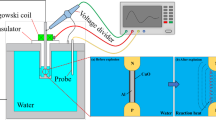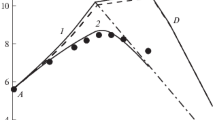Abstract
In this paper, a series of experiments were performed to study the energy output characteristics of CL-20-based aluminized explosives in an explosion vessel. The influences of different aluminum mass contents on the shock wave pressure and the explosion power were systematically investigated. The results showed that the peak overpressure and the positive impulse of the initial shock wave decreased with the aluminum content increased from 10 to 30%. On the contrary, the quasi-static pressure increased. The deformation and damage degree of sealing steel plates of the explosion vessel decreased as the aluminum content increased. The analysis indicated that the maximum residual deflection of the steel plates mainly represented the energy of the initial shock wave. The explosion power of the CL-20-based aluminized explosives decreased with the increase in aluminum content, and this trend was more remarkable at a large charge mass. The contrast test with LiF showed that the energy released from the combustion of aluminum can improve the positive impulse of the initial shock wave and play a role in the deformation of steel plates.















Similar content being viewed by others
References
Trzciński, W.A., Cudziło, S., Paszula, J.: Studies of free field and confined explosions of aluminum enriched RDX compositions. Propellants Explos. Pyrotech. 32(6), 502–506 (2007). https://doi.org/10.1002/prep.200700202
Simpson, R.L., Urtiew, P.A., Ornellas, D.L., Moody, G.L., Scribner, K.J., Hoffman, D.M.: CL-20 performance exceeds that of HMX and its sensitivity is moderate. Propellants Explos. Pyrotech. 22, 249–255 (1997). https://doi.org/10.1002/prep.19970220502
Sider, A.K., Sikder, N., Gandhe, B.R.: Hexanitrohexaazaisowurtaitane or CL-20 in India: synthesis and characterization. Defense Sci. J. 52(2), 135–146 (2002). https://doi.org/10.14429/dsj.52.2158
Wang, F.P., Chen, L., Geng, D.S.: Effect of density on the thermal decomposition mechanism of epsilon-CL-20: a ReaxFF reactive molecular dynamics simulation study. Phys. Chem. Chem. Phys. 20(35), 22600–22609 (2018). https://doi.org/10.1039/c8cp03010c
Mao, X.X., Zhu, C.G., Li, Y.C., Li, Y.F., Jiang, L.F., Wang, X.M.: The effect of micro-sized aluminum powder on thermal decomposition of HNIW (CL-20). Adv. Mater. Sci. Eng. 2019, 6487060 (2019). https://doi.org/10.1155/2019/6487060
Zhu, Y.F., Luo, J., Lu, Y.W.: Emulsion synthesis of CL-20/DNA composite with excellent superfine spherical improved sensitivity performance via a combined ultrasonic microwave irradiation approach. J. Mater. Sci. 53, 14231–14240 (2018). https://doi.org/10.1007/s10853-018-2644-2
Liu, D.Y., Chen, L., Wang, C., Wu, J.Y.: Detonation reaction characteristics for CL-20 and CL-20-based aluminized mixed explosives. Cent. Eur. J. Energ. Mater. 14, 573–588 (2017). https://doi.org/10.22211/cejem/75114
Liu, D.Y., Chen, L., Wang, C., Wu, J.Y.: Aluminum acceleration and reaction characteristics for aluminized CL-20-based mixed explosives. Propellants Explos. Pyrotech. 43(6), 543–551 (2018). https://doi.org/10.1002/prep.201700266
Jiao, Q.J., Wang, Q.S., Nie, J.X., Guo, X.Y., Zhang, W., Fan, W.Q.: The effect of explosive percentage on underwater explosion energy release of hexanitrohexaazaisowurtzitane and octogen based aluminized explosives. AIP Adv. 8(3), 035013 (2018). https://doi.org/10.1063/1.5023262
Mao, X.X., Jiang, L.F., Zhu, C.G., Wang, X.M.: Effects of aluminum powder on ignition performance of RDX, HMX, and CL-20 explosives. Adv. Mater. Sci. Eng. 2018(4), 5913216 (2018). https://doi.org/10.1155/2018/5913216
Anderson Jr., C.E., Baker, W.E., Wauters, D.K., Morris, B.L.: Quasi-static pressure, duration, and impulse for explosions (e.g. HE) in structures. Int. J. Mech. Sci. 25(6), 455–464 (1983). https://doi.org/10.1016/0020-7403(83)90059-0
Dong, Q., Li, Q.M., Zheng, J.Y.: Interactive mechanisms between the internal blast loading and the dynamic elastic response of spherical containment vessels. Int. J. Impact Eng 37(4), 349–358 (2010). https://doi.org/10.1016/j.ijimpeng.2009.10.004
Hu, Y., Wu, C.Q., Lukaszewicz, M., Dragos, J.: Characteristics of confined blast loading in unvented structures. Int. J. Protect. Struct. 2(1), 21–43 (2011). https://doi.org/10.1260/2041-4196.2.1.21
Dragos, J., Wu, C.Q., Oehlers, D.J.: Simplification of fully confined blasts for structural response analysis. Eng. Struct. 56, 312–326 (2013). https://doi.org/10.1016/j.engstruct.2013.05.018
Geretto, C., Chung, K.Y., Nurick, G.N.: An experimental study of the effects of degrees of confinement on the response of square mild steel plates subjected to blast loading. Int. J. Impact Eng 79, 32–44 (2015). https://doi.org/10.1016/j.ijimpeng.2014.08.002
Jones, N.: Structural Impact. Cambridge University Press, Cambridge (1989). https://doi.org/10.1017/CBO9780511624285
Nurick, G.N., Gelman, M.E., Marshall, N.S.: Tearing of blast loaded plates with clamped boundary conditions. Int. J. Impact Eng 18(7–8), 803–827 (1996). https://doi.org/10.1016/S0734-743X(96)00026-7
Remennikov, A., Ngo, T., Mohotti, D., Uy, B., Netherton, M.: Experimental investigation and simplified modeling of response of steel plates subjected to close-in blast loading from spherical liquid explosive charges. Int. J. Impact Eng 101, 78–89 (2017). https://doi.org/10.1016/j.ijimpeng.2016.11.013
Yao, S.J., Zhang, D., Lu, F.Y.: Dimensionless number for dynamic response analysis of box-shaped structures under internal blast loading. Int. J. Impact Eng. 98, 13–18 (2016). https://doi.org/10.1016/j.ijimpeng.2016.07.005
Manner, V.W., Pemberton, S.J., Gunderson, J.A.: The role of aluminum in the detonation and post detonation expansion of selected cast HMX-Based explosives. Propellants Explos. Pyrotech. 37, 198–206 (2012). https://doi.org/10.1002/prep.201100138
Li, X., Pei, H., Zhang, X., Zheng, X.: Effect of aluminum particle size on the performance of aluminized explosives. Propellants Explos. Pyrotech. 45(5), 807–813 (2020). https://doi.org/10.1002/prep.201900308
Duan, X.Y., Guo, X.Y., Jiao, Q.J., Zhang, J.Y., Zhang, Q.M.: Effects of Al/O on pressure properties of confined explosion from aluminized explosives. Defence Technol. 13(6), 428–433 (2017). https://doi.org/10.1016/j.dt.2017.05.018
Cook, M.A., Filler, A.S., Keyes, R.T., Partridge, W.S.: Aluminized explosives. J. Phys. Chem. 61(2), 189–196 (1957). https://doi.org/10.1021/j150548a013
Bjarnholt G.: Effects of aluminum and lithium fluoride admixtures on metal acceleration ability of Comp B. 6th International Symposium on Detonation, pp. 510–520. Office of Naval Research (1976).
Carlson R.W.: Confinement of an explosion by a steel vessel. Los Alamos Scientific Laboratory, New Mexico, LA-390(R) (1945).
Weibull, H.R.W.: Pressures recorded in partially closed chambers at explosion of TNT charges. Ann. N. Y. Acad. Sci. 152(1), 357–361 (1968). https://doi.org/10.1111/j.1749-6632.1968.tb11987.x
Feldgun, V.R., Karinski, Y.S., Edri, I., Yankelevsky, D.Z.: Prediction of the quasi-static pressure in confined and partially confined explosions and its application to blast response simulation of flexible structures. Int. J. Impact Eng 90, 46–60 (2016). https://doi.org/10.1016/j.ijimpeng.2015.12.001
Acknowledgments
The reported research was supported by the National Natural Science Foundation of China (No. 11672042).
Author information
Authors and Affiliations
Corresponding author
Additional information
Communicated by D. Frost.
Publisher's Note
Springer Nature remains neutral with regard to jurisdictional claims in published maps and institutional affiliations.
Rights and permissions
About this article
Cite this article
Jiang, C., Lu, G., Mao, L. et al. Effects of aluminum content on the energy output characteristics of CL-20-based aluminized explosives in a closed vessel. Shock Waves 31, 141–151 (2021). https://doi.org/10.1007/s00193-021-01001-1
Received:
Revised:
Accepted:
Published:
Issue Date:
DOI: https://doi.org/10.1007/s00193-021-01001-1




